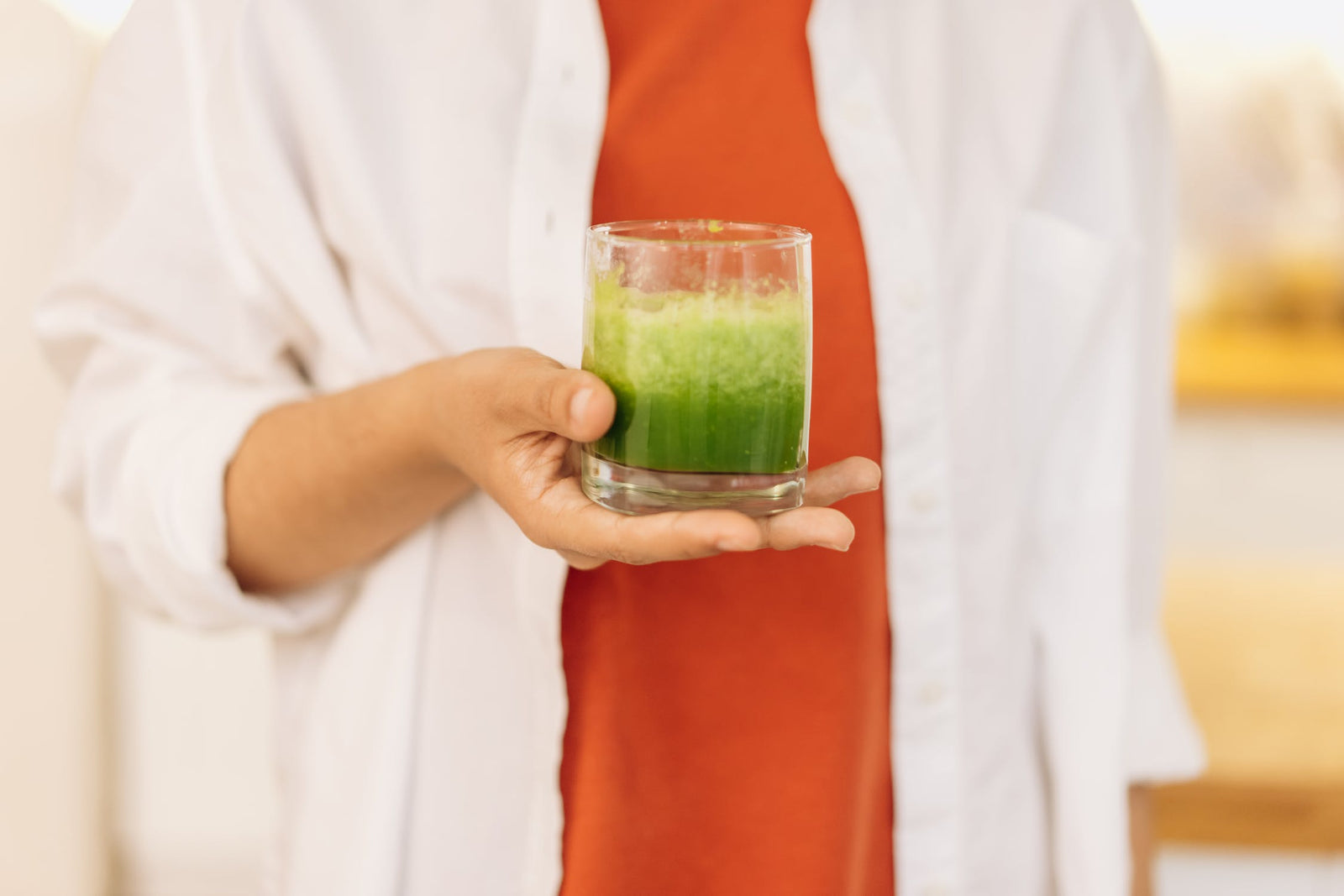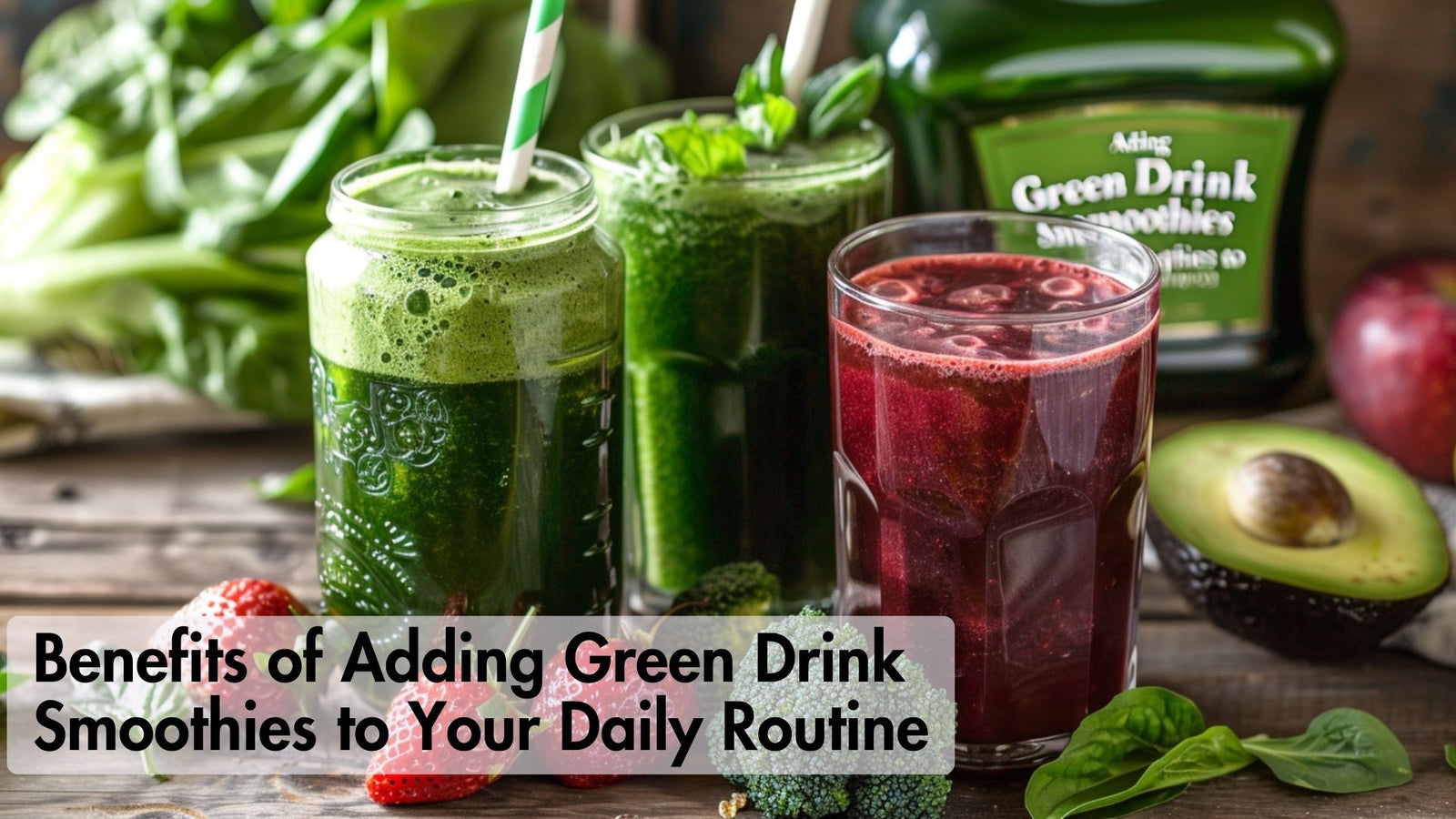Accessories
Check out our full lineup of yoga accessories to help you with your daily meditation practice and fitness goals...
Try our new Cork Yoga Brick for soft but solid support
Check out our full lineup of yoga accessories to help you with your daily meditation practice and fitness goals...
Wheatgrass: The Super Greens Powder You Shouldn't Ignore
December 21, 2023 10 min read

In the realm of health and wellness, certain foods earn the title of "superfoods" due to their dense nutritional content and associated health benefits. Among these, wheatgrass has emerged as a powerhouse, often hailed as a miracle ingredient in the world of super greens. This article delves into the world of wheatgrass, exploring why this vibrant green plant has gained such a revered status in the health community and why it's a super greens powder you shouldn't ignore.
Wheatgrass is more than just a trendy ingredient in smoothies and health drinks; it's a nutrient-rich plant that has been valued for its health-boosting properties for decades. Originating from the Triticum aestivum plant, it's harvested early in its development before it reaches full size – at the point when its nutritional value is at its peak. Traditionally consumed in fresh juice form, wheatgrass is now widely available as a powder, making it a convenient superfood addition to any diet.
The concept of super greens powders isn't new, but it has gained significant traction in recent years. These powders are a blend of highly nutritious green plants, including kale, spirulina, chlorella, and, of course, wheatgrass. They are designed to provide a concentrated dose of vitamins, minerals, and antioxidants, offering an easy and efficient way to boost your daily nutrient intake. Among these, wheatgrass stands out for its unique composition and health benefits, which we will explore in this article.
From its humble beginnings as a health secret among natural health enthusiasts, wheatgrass has now become a mainstream phenomenon. Its rise in popularity can be attributed to its impressive nutritional profile and the growing awareness of the importance of plant-based nutrients in promoting overall health and well-being. As we delve deeper into the world of wheatgrass, we'll uncover why this super greens powder deserves a place in your daily diet and how it can contribute to a healthier, more vibrant you.
What is Wheatgrass? - Exploring the Green Marvel

Wheatgrass is a name that frequently pops up in discussions about health foods and nutritional supplements. But what exactly is this green marvel?
Origin and Growth
Wheatgrass comes from the young shoots of the Triticum aestivum plant, a common wheat plant known worldwide. It's harvested just before the wheat plant reaches its full size, typically 7-10 days after sprouting, when it's believed to be brimming with phytonutrients. This timing is crucial as it captures the plant at its nutritional peak.
The cultivation of wheatgrass is simple and can be done indoors or outdoors, making it accessible for personal growth. It grows in temperate regions throughout Europe and the United States but has gained global popularity due to its health benefits.
Historical Use
The use of wheatgrass can be traced back thousands of years. Historical records suggest that ancient civilisations, such as the Egyptians and Mesopotamians, recognised the health benefits of young wheat plants. However, it wasn't until the 20th century that wheatgrass gained significant attention in the West, thanks to the efforts of nutritionists and food scientists who studied its health benefits in depth.
Basic Characteristics
Wheatgrass is characterised by its bright green colour and a slightly bitter, earthy taste. It's composed of 70% chlorophyll, which is responsible for its rich green hue. Chlorophyll is often referred to as the "blood" of plants and is structurally similar to haemoglobin in human blood, a factor that many believe contributes to its health benefits.
The plant is also a complete source of protein, supplying all nine essential amino acids, which are the building blocks of proteins in the human body. This makes it particularly valuable for vegetarians and vegans who may struggle to get enough protein from their diet.
Wheatgrass is a simple yet powerful plant, packed with a range of nutrients and a history of use that dates back centuries. Its ease of cultivation and rich nutritional profile have made it a staple in the diet of health-conscious individuals around the world.
Nutritional Profile of Wheatgrass

Wheatgrass is often lauded for its dense nutritional content, which is packed into its vibrant green blades.
Vitamins and Minerals
Wheatgrass is a treasure trove of vitamins and minerals. It is particularly rich in vitamins A, C, and E, which are known for their antioxidant properties. These vitamins play a crucial role in protecting the body from oxidative stress and supporting immune function. Additionally, wheatgrass contains B vitamins, including B12, which is a notable feature for a plant-based food, as B12 is typically found in animal products.
Minerals are another key component of wheatgrass's nutritional profile. It contains calcium, magnesium, and iron in significant amounts. Calcium is essential for bone health, magnesium supports muscle and nerve function, and iron is crucial for the formation of red blood cells.
Chlorophyll and Enzymes
One of the most remarkable features of wheatgrass is its high chlorophyll content, which makes up about 70% of its composition. Chlorophyll is not only responsible for the plant's green colour but also has been linked to various health benefits, including detoxification and promoting healthy blood flow.
Wheatgrass is also rich in enzymes, which are proteins that act as catalysts for various biological processes in the body. These include enzymes like superoxide dismutase (SOD), which plays a critical role in reducing oxidative stress and inflammation in the body.
Amino Acids and Protein
Contrary to the common perception of plant-based foods lacking in protein, wheatgrass is a complete protein source. It provides all nine essential amino acids, which the body cannot produce on its own. These amino acids are vital for muscle repair, growth, and general body function.
Antioxidants and Other Phytonutrients
Wheatgrass is abundant in antioxidants, which are compounds that help neutralise harmful free radicals in the body. This includes flavonoids and phenolic acid, which have been shown to have anti-inflammatory properties.
In addition to these, wheatgrass contains other phytonutrients that contribute to its overall health benefits. These compounds have been linked to improved digestion, better blood sugar regulation, and enhanced immune function.
Comparison with Other Greens
When compared to other green vegetables, wheatgrass stands out for its concentrated nutrient profile. While other greens like spinach and kale are healthy, wheatgrass offers a more potent dose of vitamins, minerals, and other beneficial compounds per serving.
The nutritional profile of wheatgrass is impressive, making it a potent superfood. Its combination of vitamins, minerals, chlorophyll, enzymes, amino acids, and antioxidants contributes to its reputation as a health-boosting powerhouse. Understanding this complex array of nutrients helps explain the numerous health benefits that wheatgrass can offer, which we will explore in the next section.
Health Benefits of Wheatgrass

Wheatgrass is not just a nutrient powerhouse; it's a functional food that offers a wide range of health benefits.
Detoxification and Cleansing Properties
One of the most celebrated benefits of wheatgrass is its ability to detoxify the body. The high chlorophyll content in wheatgrass is believed to help cleanse the blood and liver, aiding in the removal of toxins and impurities. This detoxifying effect can lead to increased energy levels, improved mental clarity, and a general sense of well-being.
Immune System Support and Disease Prevention
Wheatgrass is rich in antioxidants and nutrients that bolster the immune system. The antioxidants, particularly vitamins C and E, help protect the body against oxidative stress and reduce the risk of chronic diseases, including heart disease. The immune-boosting properties of wheatgrass make it a valuable addition to any diet, especially during cold and flu season.
Digestive Health Benefits
The high fibre content in wheatgrass, along with its digestive enzymes, makes it an excellent aid for digestion. It can help regulate bowel movements, reduce bloating, and alleviate other digestive issues. Additionally, the alkalizing properties of wheatgrass help balance the body's pH levels, promoting a healthy gut environment.
Role in Weight Management and Metabolism
Incorporating wheatgrass into a diet can aid in weight management. Its nutrient density provides a feeling of fullness, potentially reducing cravings and overeating. Furthermore, wheatgrass has been found to have a stimulating effect on the metabolism, helping the body to burn calories more efficiently.
Skin Health and Anti-Aging Effects
The vitamins and antioxidants in wheatgrass can have a positive impact on skin health. These nutrients help in the repair and regeneration of skin cells, leading to improved skin tone and texture. The anti-inflammatory properties of wheatgrass also help in reducing acne and skin irritations. Additionally, the antioxidants combat free radical damage, which is linked to ageing and wrinkles.
The health benefits of wheatgrass are extensive and varied. From detoxifying the body and boosting the immune system to aiding digestion, enhancing skin health, and supporting weight management, wheatgrass proves to be a versatile and potent superfood. Its comprehensive range of nutrients not only nourishes the body but also helps in addressing various health concerns, making it an invaluable addition to a healthy lifestyle. As we continue to explore wheatgrass, particularly in its popular powdered form, we'll see how easy it is to incorporate this super green into our daily routines.
Wheatgrass as a Super Greens Powder

While fresh wheatgrass juice has its benefits, the powdered form of wheatgrass has gained immense popularity for its convenience and concentrated nutritional value. This section explores why wheatgrass powder is a standout choice among super greens powders and how it can be easily incorporated into your daily diet.
The Process of Powdering Wheatgrass
Wheatgrass powder is made by first dehydrating fresh wheatgrass and then grinding it into a fine powder. This process preserves the essential nutrients, enzymes, and chlorophyll found in fresh wheatgrass, ensuring that the powder retains its health benefits. The dehydration process also removes the water content, resulting in a more concentrated form of wheatgrass, meaning you get more nutrients in every scoop compared to the fresh juice.
Benefits of Wheatgrass Powder
The powdered form of wheatgrass offers several advantages:
- Convenience: Wheatgrass powder is easy to store and has a longer shelf life than fresh wheatgrass or its juice. It eliminates the need for juicing, which can be time-consuming and requires fresh wheatgrass, which isn't always readily available.
- Ease of Use: The powder can be easily mixed into water, smoothies, juices, or other beverages, making it a simple way to boost your nutrient intake without altering your diet significantly.
- Portability: Being in powder form, it's easy to take wheatgrass with you when travelling, ensuring you can maintain your health regimen wherever you go.
- Concentration of Nutrients: As mentioned, the dehydration process concentrates the nutrients, making wheatgrass powder a more potent source of vitamins, minerals, enzymes, and chlorophyll.
Incorporating Wheatgrass Powder into Your Diet
Wheatgrass powder is incredibly versatile and can be added to a variety of foods and drinks. Here are some simple ways to include it in your diet:
- Smoothies: Blend wheatgrass powder into your favourite fruit or vegetable smoothies.
- Juices: Stir it into fresh fruit or vegetable juices for an extra nutrient kick.
- Teas: Mix it into warm water with lemon and honey to make a soothing tea.
- Yogurt and Cereals: Sprinkle wheatgrass powder over your yoghourt or cereal for a nutritious start to your day.
- Salad Dressings: Incorporate it into homemade salad dressings for a healthy and flavourful twist.
Who Can Benefit from Wheatgrass Powder?
Wheatgrass powder is suitable for almost everyone, from busy professionals and athletes to health-conscious individuals and those with dietary restrictions. It's particularly beneficial for those looking to increase their intake of greens, people with digestive issues, and anyone seeking a natural detoxification aid.
Wheatgrass powder is a convenient, versatile, and potent way to enjoy the benefits of this super green. Its ease of use and the concentrated form make it an ideal choice for those looking to boost their health without significant dietary changes.
Scientific Studies and Research

The health benefits of wheatgrass, while widely touted in wellness circles, are also backed by scientific research. Below we delve into key studies and findings that shed light on the efficacy of wheatgrass in various health aspects, providing a scientific perspective on its benefits.
Overview of Key Studies
- Nutritional Analysis: Several studies have analysed the nutritional content of wheatgrass, confirming its rich composition of vitamins, minerals, enzymes, and chlorophyll. These studies validate wheatgrass as a nutrient-dense food.
- Antioxidant Properties: Research has demonstrated that wheatgrass possesses strong antioxidant properties, which play a crucial role in reducing oxidative stress and inflammation in the body. These properties are linked to the prevention of chronic diseases and improved overall health.
- Blood Sugar Regulation: Research has indicated that wheatgrass may have a beneficial effect on blood sugar levels. A study in the "Journal of Herbal Medicine" suggested that wheatgrass could improve glycemic control, making it a potential dietary supplement for managing diabetes.
- Digestive Health: Wheatgrass has been studied for its impact on digestive health, particularly in the context of ulcerative colitis. A study in the "Scandinavian Journal of Gastroenterology" found that wheatgrass juice might help reduce the severity of symptoms and improve overall quality of life for patients with this condition.
- Detoxification Effects: While more research is needed, some studies have pointed to the detoxifying effects of wheatgrass, especially in liver health. These studies suggest that wheatgrass may aid in liver detoxification and improve liver function.
The body of scientific research on wheatgrass supports many of the health claims made about this superfood. While further research is necessary to fully understand its benefits and applications, the current evidence positions wheatgrass as a valuable component of a healthy diet.
Conclusion: Wheatgrass - The Super Greens Powder
As we conclude our exploration of wheatgrass, it's clear that this super greens powder is more than just a passing health fad. Its rich nutritional profile, backed by scientific research, positions wheatgrass as a valuable addition to a balanced diet.
Recap of Wheatgrass Benefits
- Nutrient-Rich: Wheatgrass is packed with vitamins, minerals, enzymes, and chlorophyll, offering a concentrated source of essential nutrients.
- Health-Boosting Properties: From detoxification and immune support to aiding digestion and promoting skin health, wheatgrass contributes to various aspects of well-being.
- Scientifically Supported: Research, though still evolving, supports many of the health claims associated with wheatgrass, particularly its antioxidant and anti-inflammatory effects.
Incorporating Wheatgrass into Your Diet
- Versatility: Wheatgrass powder can be easily added to smoothies, juices, teas, and even foods like yoghurt and salad dressings.
- Convenience: The powdered form offers a practical and straightforward way to enjoy the benefits of wheatgrass, especially for those with busy lifestyles.
Who Can Benefit?
- Wheatgrass is suitable for a wide range of individuals, from health enthusiasts and athletes to those with specific health concerns like digestive issues or a need for enhanced nutritional intake.
Final Thoughts
Wheatgrass represents a simple yet powerful way to enhance your health. Whether you're looking to boost your nutrient intake, support your body's natural detoxification processes, or simply add more greens to your diet, wheatgrass is an excellent choice. Its ease of use, combined with its potent health benefits, makes it a superfood that is hard to ignore.
As with any dietary supplement, it's important to consider wheatgrass as part of a balanced diet and healthy lifestyle. While it's a powerful health enhancer, it's not a cure-all and should be used in conjunction with other healthful practices.
Wheatgrass is a super greens powder that offers a multitude of health benefits. Its nutritional richness and health-boosting properties make it a worthy addition to anyone's diet, especially those seeking to improve their overall health and wellness. As more research unfolds, we can only expect to discover even more about the wonders of this vibrant green superfood.
Discover the power of wheatgrass and other super greens with Lean Greens' range of products, designed to flood your body with nutrients in just 30 seconds.
Further reading
For further reading on the health benefits and research surrounding wheatgrass, here are some valuable resources:
- The Medical Use of Wheatgrass: Review of the Gap Between Basic and Clinical Applications - This scientific review, available on PubMed, discusses clinical trials showing the benefits of wheatgrass in chemotherapy and its potential in attenuating chemotherapy-related side effects. Read more on PubMed
- 7 Evidence-Based Benefits of Wheatgrass - Healthline provides an article detailing seven scientifically supported benefits of wheatgrass, including its nutritional value and potential health impacts like reducing cholesterol and other risks. Read the article on Healthline
- Wheatgrass: Health Benefits, Nutrition Information, How to Use It - WebMD offers an overview of wheatgrass, including its health benefits, nutritional information, and tips on how to use it. This resource is particularly useful for understanding how wheatgrass may help regulate blood sugar levels and its benefits for people with diabetes. Explore more on WebMD

Reduce Bloating: How Superfoods Can Aid Digestive Comfort
February 28, 2024 9 min read
Bloating, a common digestive issue, affects many individuals worldwide. Characterised by a feeling of fullness, tightness, or swelling in the abdomen, bloating can be both uncomfortable and distressing. While it's often a result of overeating or consuming certain foods that the body finds hard to digest, bloating can also be a symptom of various underlying health conditions. It's a physical discomfort that can also impact one's self-esteem and quality of life.
Read More

Green Smoothie Recipes: Incorporating Superfoods for a Health Boost
February 21, 2024 10 min read
Green smoothies are more than just a health trend; they are a powerful way to enhance your daily nutrition and overall well-being. At the heart of these vibrant drinks are leafy greens – packed with essential vitamins, minerals, and fibre – blended into a convenient and delicious form. But what elevates a green smoothie from merely nutritious to a powerhouse of health? The answer lies in the incorporation of superfoods.
Read More

Discover the Benefits of Adding Green Drink Smoothies to Your Daily Routine
February 17, 2024 7 min read
Discover the benefits of adding green drink smoothies to your daily routine. Enhance your health and well-being with nutrient-rich beverages that improve digestion, boost energy levels, and support weight management. Start your journey to better health with Lean Greens today.
Read More